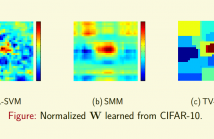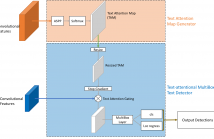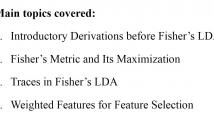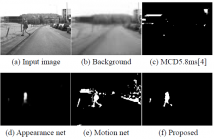
- Read more about TV-SVM: Support Vector Machine with Total Variational Regularization
- Log in to post comments
To leverage the spatial relationship of lattice data, such as images, we introduce total variational (TV) regularization into support vector machines (SVM), called TV-SVM. TV-SVM encourages local smoothness and sparsity in gradient domain of the learned parameters. TV-SVM is optimized via the alternating direction method of multipliers (ADMM) algorithm and is significantly better than (Linear) SVM for image classifications.
- Categories:
 3 Views
3 Views
- Read more about TV-SVM: Support Vector Machine with Total Variational Regularization
- Log in to post comments
To leverage the spatial relationship of lattice data, such as images, we introduce total variational (TV) regularization into support vector machines (SVM), called TV-SVM. TV-SVM encourages local smoothness and sparsity in gradient domain of the learned parameters. TV-SVM is optimized via the alternating direction method of multipliers (ADMM) algorithm and is significantly better than (Linear) SVM for image classifications.
- Categories:
 50 Views
50 Views- Categories:
 4 Views
4 Views- Categories:
 13 Views
13 Views
- Read more about Efficient Segmentation-Aided Text Detection for Intelligent Robots_Slides
- Log in to post comments
Scene text detection is a critical prerequisite for many fascinating applications for vision-based intelligent robots. Existing methods detect texts either using the local information only or casting it as a semantic segmentation problem. They tend to produce a large number of false alarms or cannot separate individual words accurately. In this work, we present an elegant segmentation-aided text detection solution that predicts the word-level bounding boxes using an end-to-end trainable deep convolutional neural network.
- Categories:
 9 Views
9 Views- Read more about A Framework to Enhance Assistive Technology-based Mobility Tracking in Individuals with Spinal Cord Injury
- Log in to post comments
Assistive technologies such as wheelchairs, canes, and walkers have significantly improved the mobility, function, and quality of life for individuals with spinal cord injury (SCI). In this article, we propose a framework which combines machine learning algorithms with wearable sensors to capture and track mobility in individuals with SCI. Pilot testing in two individuals without SCI indicated that four to seven features obtained from sensors worn on the body or placed on the assistive technology could successfully detect mobility and mobility modes.
- Categories:
 8 Views
8 Views- Read more about Efficient Segmentation-Aided Text Detection for Intelligent Robots_Poster
- Log in to post comments
Scene text detection is a critical prerequisite for many fascinating applications for vision-based intelligent robots. Existing methods detect texts either using the local information only or casting it as a semantic segmentation problem. They tend to produce a large number of false alarms or cannot separate individual words accurately. In this work, we present an elegant segmentation-aided text detection solution that predicts the word-level bounding boxes using an end-to-end trainable deep convolutional neural network.
- Categories:
 8 Views
8 Views
- Read more about Fisher’s Linear Discriminant Analysis and Its Use in Feature Selection
- Log in to post comments
Introductory derivations are done before introducing the metric of Fisher’s LDA. Then, after introducing Fisher's LDA and its different forms, Fisher’s Metrics and their maximizations are given. The idea of traces in Fisher's LDA is explained. Weighted features method is used for feature selection. Various simple examples are provided to clarify the idea for the feature selection.
Sunu1.pptx
- Categories:
 238 Views
238 Views
- Read more about LOCALIZED MULTI-KERNEL DISCRIMINATIVE CANONICAL CORRELATION ANALYSIS FOR VIDEO-BASED PERSON RE-IDENTIFICATION
- Log in to post comments
- Categories:
 12 Views
12 Views
- Read more about Appearance and Motion based Deep Learning Architecture for Moving Object Detection in Moving Camera
- Log in to post comments
Background subtraction from the given image is a widely used method for moving object detection. However, this method is vulnerable to dynamic background in a moving camera video. In this paper, we propose a novel moving object detection approach using deep learning to achieve a robust performance even in a dynamic background. The proposed approach considers appearance features as well as motion features. To this end, we design a deep learning architecture composed of two networks: an appearance network and a motion network.
ICIP17_heo.pdf
- Categories:
 66 Views
66 Views